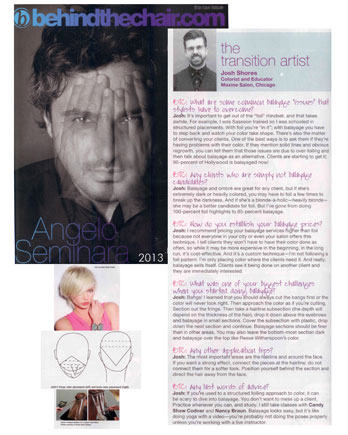Behind the Chair.com The Raw Issue 2013
Behind The Chair.com
Tuesday August 27, 2013
the raw issue
The Transition Artist
Colorist and Educator
Maxine Salon,Chicago
BTC: What are some common balayage "issues" that stylists have to overcome?
Colorist: It's important to get out of the "foil" mindset, and that takes awhile. For example, I was Sassoon trained so I was schooled in structured placement. With foil you're "in it"; with balayage you have to step back and watch your color take shape. There's also the matter of converting your clients. One of the best ways is to ask them if they're having problems with their color. If they mention solid lines and obvious regrowth, you can tell them that those issues are due to over-foiling and then talk about balayage as an alternative. Clients are starting to get it; 90-percent of Hollywood is balayaged now!
BTC: Any clients who are simply not balayage candidates?
Colorist: Balayage and ombre are great for any client, but if she's extremely dark or heavily colored, you may have to foil a few times to break up the darkness. And if she's a blonde-a-holic - heavily blond- she may be a better candidate for foil. But I've gone from doing 100-percent foil highlights to 85-percent balayage.
BTC: How do you establish your balayage prices?
Colorist: I recommend pricing your balayage services higher than foil becuase not everyone in your city or even your salon offers this technique. I tell clients they won't have to have their color done as often, so while it may be more expensive in the beginning, in the long run, it's cost-effective. And it's a custom technique-I'm not following a foil pattern. I'm only placing color where the clients need it. And really, balayage sells itself. Clients see it being done on another client and they are immediately interested.
BTC: What was one of your biggest challenges when you started doing balayage?
Colorist: Bangs! I learned that you should always cut the bangs first or the color will never look right. Then approach the color as if you're cutting. Section out the fringe. then take a hairline subsection (the depth will depend on teh thickness of the hair), drop it down above the eyebrows and balayage in small sections. Cover the subsection with plastic, drop down the next section and continue. Balayage sections should be finer than in ohter areas. You may also leave the bottom-most section dark and balayage over the top like Reese Witherspoon's color.
BTC: Any other application tips?
Colorist: The most important areas are the hairline and around the face. If you want a stron effect, connect teh pieces at the hairline; do not connect them for a softer look. Position yourself behind the section and direct the hair away from the face.
BTC: Any last words of advice?
Colorist: If you're used to a structured foiling approach to color, it can be scary to dive into balayage. you don't want to mess up a client. Practice whenever you can, and study. I still take classes with Candy Shaw Codner and Nancy Braun. Balayage looks easy, but it's like doing yoga with a video-you're probably not doing the poses properly unless you're working with a live instructor.
